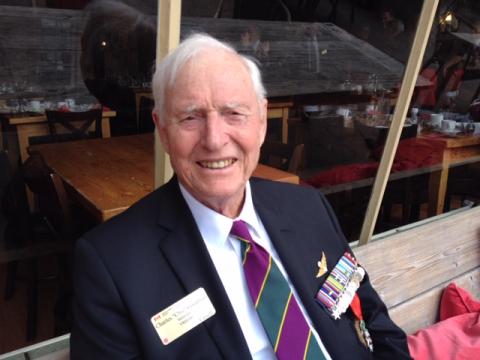
Goodman came home from his service with a souvenir he would only uncover 25 years later. He served in France and Belgium and was wounded in the Netherlands during the fighting in the Scheldt Estuary. His regiment was positioned near a Dutch farmhouse when they were attacked by the Germans and ended up covered in shrapnel. Goodman spent two weeks in a field hospital near Antwerp. Twenty-five years later, a British doctor would discover a piece of shrapnel, the size of a thumbnail, still lodged in his chest. His son now has this piece of shrapnel as a reminder of his father’s service.
After recovering from his wounds, Goodman returned to his regiment which was sent to the Nijmegen salient. They remained in the area until the Allied advance into Germany in early February 1945. That same February, Goodman turned 19, becoming officially old enough to be deployed overseas. He had actually enlisted at the age of 15 and managed to get deployed despite his young age.
Goodman’s regiment moved around often and after crossing the Rhine, the South Saskatchewan turned north, back into the Netherlands where they liberated the German Concentration Kamp Westerbork. This camp was used as a sorting camp where the fittest would be sent to labour camps while the others were sent to their death.
“To actually meet someone who we had liberated 70 years ago, to learn his story and how my regiment had saved his family’s life, was meaningful and touching.”
The liberation of this camp was a very emotional experience for Goodman. Five years ago, he returned there to speak about his experiences. Following his speech, a Dutch citizen who, as a young boy, had been sent to this camp with his parents, came over to Goodman, kissed him on the cheeks and thanked him for liberating his family. It’s a moment Goodman will never forget. “To actually meet someone who we had liberated 70 years ago, to learn his story and how my regiment had saved his family’s life, was meaningful and touching.”
Following the liberation of the camp, the regiment proceeded further north and took part in the liberation of Groningen. It was here that Goodman witnessed first-hand how hungry and desperate the citizens of Groningen were as a result of the German occupation. “I was operating a radio with the Bren Gun carrier platoon when we entered Groningen. We started to clear the houses along the canal, and did not find any Germans. However, one of the Dutch residents informed us that German soldiers were hiding in barges moored along the canal. In the next hour, we captured 20 to 30 Germans hiding in ten different barges.”
“When we reached the town square, I realized how hungry the Dutch people were.”
Goodman will always reminder the resiliency of the Dutch, and how the citizens assisted with the liberation. But, he also remembers the hard times. “When we reached the town square, I realized how hungry the Dutch people were. They were taking pieces of meat from a dead horse. The next day, all that was left was some bones and the hooves.”
The Regiment then turned east to re-enter Germany. A week before the end of the war in Europe, Goodman was at an airfield outside Oldenberg, where men from his regiment were told to stay hidden and only fire if fired upon. This was their first indication that the war was ending. The ceasefire would be declared a week later in May 1945. Goodman volunteered to remain in Europe after the war and served in the Canadian Occupation Force with the North Shore (New Brunswick) Regiment. Among other things, the regiment worked to stop the scuttling of German war ships. He returned to Canada in the summer of 1946, excited to continue his military career. He would go on to serve in Korea, the Gaza Strip, Ghana, Germany and Cyprus.
For his service during the Second World War, he was awarded the 1939-1945 Star, France and Germany Star, the Canadian Volunteer Service Medal and the French Legion of Honour Medal. Following the Second World War, Goodman received additional military medals, including the British Queen’s Korea Medal 1950, United Nations Peacekeeping medal, the United Nations Cyprus medal, and the Queen Elizabeth II Diamond Jubilee medal, just to name a few. Goodman retired with the rank of Major and now lives in Sidney, British Columbia with his wife Nancy.
In honour of the 75th anniversary of the Liberation of the Netherlands and Victory in Europe Day, Major (Ret’d) Charles “Chic” Goodman is this week’s Face of Freedom. Discover more stories.